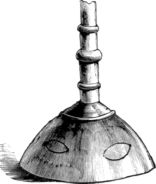MUSICAL INSTRUMENTS - online book
The History And Development Of Musical Instruments From The Earliest Times.
| Share page | Visit Us On FB |
|
MUSICAL INSTRUMENTS. |
75 |
||
|
They were also made of pottery. . The little balls in the ajacaxth of pottery, enclosed as they are, may at a first glance appear a puzzle. Probably, when the rattle was being formed they were attached to the inside as slightly as possible; and after the clay had been baked they were detached by means of an implement passed through the holes.
The Tezcucans (or Acolhuans) belonged to the same race as the Aztecs, whom they greatly surpassed in knowledge and social refinement. Nezahualcoyotl, a wise monarch of the Tezcucans, abhorred human sacrifices, and erected a large temple which he dedicated to " The unknown god, the cause of causes." This edifice had a tower nine stories high, on the top of which were placed a number of musical instruments of various kinds which were used to summon the worshippers to prayer. Respecting these instruments especial mention is made of a sonorous metal which was struck with a mallet. This is stated in a historical essay written by Ixtlilxochitl, a native of Mexico and of royal descent, who lived in the beginning of the seventeenth century, and who may be supposed to have been familiar with the musical practices of his countrymen. But whether the sonorous metal alluded to was a gong or a bell is not clear from the vague record transmitted to us. That the bell was known to the Peruvians appears to be no longer doubtful, since a small copper specimen has been found in one of the old Peruvian tombs. This interesting relic is now deposited in the museum at Lima. M. de Castel-nau has published a drawing of it, which is here reproduced. The Peruvians called their bells chanrares:.but it remains questionable whether this name did not designate rather the so-called horse
 |
|||